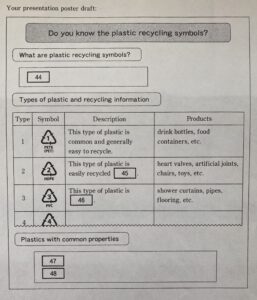今回は、第6問 A を終えて
第6問 B に入ります。
基本的な問題の扱い方
今回、このブログでは、
共通テスト(英語)の「リーディング」の問題だけを扱うこととします。
基本的な問題の扱い方は、下記の通りにします。
①問題の提示
※基本的には「大問」毎に扱う予定ですが、問題の量などによりそれより細かく区切って取り扱うこともあります。
②模範解答の提示
③解説
④そのほかの補説
第6問B:配点12点 ▶︎各3点(4問)
それでは、第6問 B の問題を見ていきましょう。
B You are in a student group preparing a poster for a scientific presentation
contest with the theme “What we should know in order to protect the
environment.” You have been using the following passage to create the poster.
|
Recycling Plastic ー The world is full of various types of plastic. Look around, and you will see |

|
ー So, what do these numbers mean? One group (numbers 2,4, and 5) is ー High-density Polyethylene is a recycle-type 2 plastic and is commonly ー Now let us look at the second group, Types 1, 3, 6, and 7. These are more ー Currently, only about 20% of plastic is recycled, and approximately 55% |

問1 Under the first poster heading, your group wants to introduce the plastic
recycling symbols as explained in the passage. Which of the following is the
most appropriate?【 44 】
① They are symbols that rank the recyclability of plastics and other
related problems.
② They provide information on the chemical make-up and recycling options
of the plastic.
③ They tell the user which standards organization gave them certificates
for general use.
④ They were introduced by ASTM and developed by the Society of the
Plastics Industry.
問2 You have been asked to write descriptions of Type 2 and Type 3 plastics.
Choose the best options for【 45 】and【 46 】.
Type 2 【 45 】
① and commonly known as a single-use plastic
② and used at a wide range of temperatures
③ but harmful to humans
④ but unsuitable for drink containers
Type 3 【 46 】
① difficult to recycle and should not be burned in the yard
② flammable; however, it is soft and cheap to produce
③ known to be a non-toxic product
④ well known for being easily recyclable
問3 You are making statements about some plastics which share common
properties. According to the article, which two of the following are
appropriate? (The order does not matter.) 【 47 】【 48 】
① Boiling water (100℃) can be served in Type 1 and Type 6 plastic containers.
② It is easy to recycle products with Type 1, 2, and 3 logos.
③ Products with the symbols 1, 2, 4, 5, and 6 are suitable for food or drink
containers.
④ Products with Type 5 and Type 6 markings are light in weight.
⑤ Type 4 and 5 plastics are heat resistant and are widely recycled.
⑥ Type 6 and 7 plastics are easy to recycle and environmentally friendly.
![]()
👉模範解答と解説は次のページです。



コメント